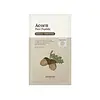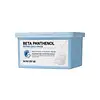What's inside
What's inside
 Key Ingredients
Key Ingredients

 Benefits
Benefits

 Concerns
Concerns

 Ingredients Side-by-side
Ingredients Side-by-side

Water
Skin ConditioningQuercus Acutissima Fruit Extract 20%
AstringentPropanediol
SolventGlycerin
HumectantDipropylene Glycol
HumectantMethylpropanediol
SolventNiacinamide
SmoothingDiethoxyethyl Succinate
SolventHydroxyacetophenone
AntioxidantButylene Glycol
Humectant1,2-Hexanediol
Skin ConditioningAcrylates/C10-30 Alkyl Acrylate Crosspolymer
Emulsion StabilisingPPG-13-Decyltetradeceth-24
EmulsifyingPCA Dimethicone
Skin ConditioningTromethamine
BufferingAllantoin
Skin ConditioningTrehalose
HumectantAdenosine
Skin ConditioningHydroxyethylcellulose
Emulsion StabilisingDiospyros Kaki Fruit Extract
Skin ConditioningCamellia Sinensis Leaf Extract
AntimicrobialCastanea Crenata Shell Extract
Skin ConditioningPolyglyceryl-4 Oleate
EmulsifyingEthylhexylglycerin
Skin ConditioningSodium Phytate
Enantia Chlorantha Bark Extract
Skin ConditioningDextrin
AbsorbentTheobroma Cacao Extract
Skin ConditioningSodium Polyacryloyldimethyl Taurate
Emulsion StabilisingGlyceryl Acrylate/Acrylic Acid Copolymer
HumectantCollagen
MoisturisingEucalyptus Globulus Leaf Oil
PerfumingRosmarinus Officinalis Leaf Oil
MaskingAmyris Balsamifera Bark Oil
MaskingHydrolyzed Lupine Protein
Skin ConditioningLeuconostoc/Radish Root Ferment Filtrate
AntimicrobialSalvia Officinalis Oil
MaskingSodium Stearoyl Glutamate
CleansingCitrus Aurantium Bergamia Fruit Oil
MaskingGluconolactone
Skin ConditioningHelianthus Annuus Seed Oil
EmollientPueraria Lobata Root Extract
HumectantUlmus Davidiana Root Extract
Skin ConditioningOenothera Biennis Flower/Leaf/Stem Extract
Skin ConditioningPinus Palustris Leaf Extract
TonicBeta-Glucan
Skin ConditioningSalvia Sclarea Oil
MaskingPalmitoyl Tripeptide-5
Skin ConditioningOleanolic Acid
Skin ConditioningCaprylyl Glycol
EmollientWater, Quercus Acutissima Fruit Extract 20%, Propanediol, Glycerin, Dipropylene Glycol, Methylpropanediol, Niacinamide, Diethoxyethyl Succinate, Hydroxyacetophenone, Butylene Glycol, 1,2-Hexanediol, Acrylates/C10-30 Alkyl Acrylate Crosspolymer, PPG-13-Decyltetradeceth-24, PCA Dimethicone, Tromethamine, Allantoin, Trehalose, Adenosine, Hydroxyethylcellulose, Diospyros Kaki Fruit Extract, Camellia Sinensis Leaf Extract, Castanea Crenata Shell Extract, Polyglyceryl-4 Oleate, Ethylhexylglycerin, Sodium Phytate, Enantia Chlorantha Bark Extract, Dextrin, Theobroma Cacao Extract, Sodium Polyacryloyldimethyl Taurate, Glyceryl Acrylate/Acrylic Acid Copolymer, Collagen, Eucalyptus Globulus Leaf Oil, Rosmarinus Officinalis Leaf Oil, Amyris Balsamifera Bark Oil, Hydrolyzed Lupine Protein, Leuconostoc/Radish Root Ferment Filtrate, Salvia Officinalis Oil, Sodium Stearoyl Glutamate, Citrus Aurantium Bergamia Fruit Oil, Gluconolactone, Helianthus Annuus Seed Oil, Pueraria Lobata Root Extract, Ulmus Davidiana Root Extract, Oenothera Biennis Flower/Leaf/Stem Extract, Pinus Palustris Leaf Extract, Beta-Glucan, Salvia Sclarea Oil, Palmitoyl Tripeptide-5, Oleanolic Acid, Caprylyl Glycol
Water
Skin ConditioningButylene Glycol
HumectantNiacinamide
SmoothingGlycerin
HumectantPanthenol
Skin ConditioningPropanediol
SolventDipropylene Glycol
HumectantOlea Europaea Fruit Oil
MaskingGlycereth-26
HumectantPolyglyceryl-10 Laurate
Skin ConditioningHydroxyacetophenone
AntioxidantCaprylyl Glycol
EmollientXanthan Gum
EmulsifyingEthylhexylglycerin
Skin Conditioning1,2-Hexanediol
Skin ConditioningAcrylates/C10-30 Alkyl Acrylate Crosspolymer
Emulsion StabilisingArginine
MaskingPolyglyceryl-3 Methylglucose Distearate
EmulsifyingGlyceryl Stearate Se
EmulsifyingPantolactone
HumectantMethyl Glucose Sesquistearate
EmollientDipotassium Glycyrrhizate
HumectantAllantoin
Skin ConditioningCitric Acid
BufferingSodium Citrate
BufferingSodium Hyaluronate
HumectantDiethylhexyl Sodium Sulfosuccinate
CleansingXylitylglucoside
HumectantMusa Sapientum Fruit Extract
Skin ConditioningAnhydroxylitol
HumectantRosa Damascena Flower Water
MaskingPyrus Communis Fruit Extract
Skin ConditioningPrunus Domestica Fruit Extract
MoisturisingXylitol
HumectantCucumis Melo Fruit Extract
Skin ConditioningGlyceryl Glucoside
HumectantHedera Helix Leaf/Stem Extract
AntimicrobialOctyldodecanol
EmollientEctoin
Skin ConditioningHydrogenated Lecithin
EmulsifyingBeta-Sitosterol
Emulsion StabilisingGlucose
HumectantSodium Palmitoyl Sarcosinate
CleansingLactobacillus Ferment Lysate
Skin ConditioningHydrolyzed Sodium Hyaluronate
Skin ConditioningDimethylsilanol Hyaluronate
HumectantHydrolyzed Hyaluronic Acid
HumectantHyaluronic Acid
HumectantPotassium Hyaluronate
Skin ConditioningHydroxypropyltrimonium Hyaluronate
Sodium Hyaluronate Crosspolymer
HumectantSodium Hyaluronate Dimethylsilanol
HumectantCeramide NP
Skin ConditioningSodium Acetylated Hyaluronate
HumectantAcetyl Tetrapeptide-40
Skin ConditioningDisodium EDTA
Water, Butylene Glycol, Niacinamide, Glycerin, Panthenol, Propanediol, Dipropylene Glycol, Olea Europaea Fruit Oil, Glycereth-26, Polyglyceryl-10 Laurate, Hydroxyacetophenone, Caprylyl Glycol, Xanthan Gum, Ethylhexylglycerin, 1,2-Hexanediol, Acrylates/C10-30 Alkyl Acrylate Crosspolymer, Arginine, Polyglyceryl-3 Methylglucose Distearate, Glyceryl Stearate Se, Pantolactone, Methyl Glucose Sesquistearate, Dipotassium Glycyrrhizate, Allantoin, Citric Acid, Sodium Citrate, Sodium Hyaluronate, Diethylhexyl Sodium Sulfosuccinate, Xylitylglucoside, Musa Sapientum Fruit Extract, Anhydroxylitol, Rosa Damascena Flower Water, Pyrus Communis Fruit Extract, Prunus Domestica Fruit Extract, Xylitol, Cucumis Melo Fruit Extract, Glyceryl Glucoside, Hedera Helix Leaf/Stem Extract, Octyldodecanol, Ectoin, Hydrogenated Lecithin, Beta-Sitosterol, Glucose, Sodium Palmitoyl Sarcosinate, Lactobacillus Ferment Lysate, Hydrolyzed Sodium Hyaluronate, Dimethylsilanol Hyaluronate, Hydrolyzed Hyaluronic Acid, Hyaluronic Acid, Potassium Hyaluronate, Hydroxypropyltrimonium Hyaluronate, Sodium Hyaluronate Crosspolymer, Sodium Hyaluronate Dimethylsilanol, Ceramide NP, Sodium Acetylated Hyaluronate, Acetyl Tetrapeptide-40, Disodium EDTA
Ingredients Explained
These ingredients are found in both products.
Ingredients higher up in an ingredient list are typically present in a larger amount.
1,2-Hexanediol is a synthetic liquid and another multi-functional powerhouse.
It is a:
- Humectant, drawing moisture into the skin
- Emollient, helping to soften skin
- Solvent, dispersing and stabilizing formulas
- Preservative booster, enhancing the antimicrobial activity of other preservatives
Acrylates/C10-30 Alkyl Acrylate Crosspolymer is a synthetic polymer. It is used to thicken and improve the texture of products. Due to its properties, it can prevent water and oil ingredients from separating.
Allantoin is a soothing ingredient known for its protective and moisturizingg properties. Because of this, it is often added to products with strong active ingredients.
Studies show higher concentrations of this ingredient can promote wound healing.
Though it can be derived from the comfrey plant, allantoin is produced synthetically for cosmetic products to ensure purity.
Learn more about AllantoinButylene Glycol (or BG) is used within cosmetic products for a few different reasons:
Overall, Butylene Glycol is a safe and well-rounded ingredient that works well with other ingredients.
Though this ingredient works well with most skin types, some people with sensitive skin may experience a reaction such as allergic rashes, closed comedones, or itchiness.
Learn more about Butylene GlycolCaprylyl Glycol is a humectant and emollient, meaning it attracts and preserves moisture.
It is a common ingredient in many products, especially those designed to hydrate skin. The primary benefits are retaining moisture, skin softening, and promoting a healthy skin barrier.
Though Caprylyl Glycol is an alcohol derived from fatty acids, it is not the kind that can dry out skin.
This ingredient is also used as a preservative to extend the life of products. It has slight antimicrobial properties.
Learn more about Caprylyl GlycolDipropylene Glycol is a synthetically created humectant, stabilizer, and solvent.
This ingredient helps:
Dipropylene glycol is technically an alcohol, but it belongs to the glycol family (often considered part of the ‘good’ alcohols). This means it is hydrating and gentle on skin unlike drying solvent alcohols like denatured alcohol.
As a masking agent, Dipropylene Glycol can be used to cover the smell of other ingredients. However, it does not have a scent.
Studies show Dipropylene Glycol is considered safe to use in skincare.
Learn more about Dipropylene GlycolEthylhexylglycerin (we can't pronounce this either) is commonly used as a preservative and skin softener. It is derived from glyceryl.
You might see Ethylhexylglycerin often paired with other preservatives such as phenoxyethanol. Ethylhexylglycerin has been found to increase the effectiveness of these other preservatives.
Glycerin is already naturally found in your skin. It helps moisturize and protect your skin.
A study from 2016 found glycerin to be more effective as a humectant than AHAs and hyaluronic acid.
As a humectant, it helps the skin stay hydrated by pulling moisture to your skin. The low molecular weight of glycerin allows it to pull moisture into the deeper layers of your skin.
Hydrated skin improves your skin barrier; Your skin barrier helps protect against irritants and bacteria.
Glycerin has also been found to have antimicrobial and antiviral properties. Due to these properties, glycerin is often used in wound and burn treatments.
In cosmetics, glycerin is usually derived from plants such as soybean or palm. However, it can also be sourced from animals, such as tallow or animal fat.
This ingredient is organic, colorless, odorless, and non-toxic.
Glycerin is the name for this ingredient in American English. British English uses Glycerol/Glycerine.
Learn more about GlycerinHydroxyacetophenone is antioxidant with skin conditioning and soothing properties. It also boosts the efficiency of preservatives.
This ingredient is not irritating or sensitizing.
Niacinamide is a multitasking form of vitamin B3 that strengthens the skin barrier, reduces pores and dark spots, regulates oil, and improves signs of aging.
And the best part? It's gentle and well-tolerated by most skin types, including sensitive and reactive skin.
You might have heard of "niacin flush", or the reddening of skin that causes itchiness. Niacinamide has not been found to cause this.
In very rare cases, some individuals may not be able to tolerate niacinamide at all or experience an allergic reaction to it.
If you are experiencing flaking, irritation, and dryness with this ingredient, be sure to double check all your products as this ingredient can be found in all categories of skincare.
When incorporating niacinamide into your routine, look out for concentration amounts. Typically, 5% niacinamide provides benefits such as fading dark spots. However, if you have sensitive skin, it is better to begin with a smaller concentration.
When you apply niacinamide to your skin, your body converts it into nicotinamide adenine dinucleotide (NAD). NAD is an essential coenzyme that is already found in your cells as "fuel" and powers countless biological processes.
In your skin, NAD helps repair cell damage, produce new healthy cells, support collagen production, strengthen the skin barrier, and fight environmental stressors (like UV and pollution).
Our natural NAD levels start to decline with age, leading to slower skin repair, visible aging, and a weaker skin barrier. By providing your skin niacinamide, you're recharging your skin's NAD levels. This leads to stronger, healthier, and younger looking skin.
Another name for vitamin B3 is nicotinamide. This vitamin is water-soluble and our bodies don't store it. We obtain Vitamin B3 from either food or skincare. Meat, fish, wheat, yeast, and leafy greens contain vitamin B3.
The type of niacinamide used in skincare is synthetically created.
Learn more about NiacinamidePropanediol is an all-star ingredient. It softens, hydrates, and smooths the skin.
It’s often used to:
Propanediol is not likely to cause sensitivity and considered safe to use. It is derived from corn or petroleum with a clear color and no scent.
Learn more about PropanediolWater. It's the most common cosmetic ingredient of all. You'll usually see it at the top of ingredient lists, meaning that it makes up the largest part of the product.
So why is it so popular? Water most often acts as a solvent - this means that it helps dissolve other ingredients into the formulation.
You'll also recognize water as that liquid we all need to stay alive. If you see this, drink a glass of water. Stay hydrated!
Learn more about Water